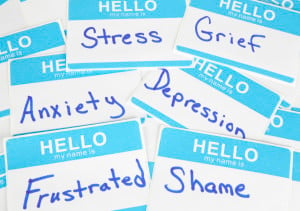
Source: The Body Is Not an Apology
Originally published on The Body Is Not an Apology and republished here with their permission.
Whenever the topic of sexually transmitted infections (STIs) comes up, I secretly get excited and panicked at the same time.
I get excited because, as a person with herpes, and specifically as a writer with herpes, I spend a lot of time considering the complexities of what it means to live in a shared body with a virus, particularly one on which society has imposed a code of silence and shame.
When it comes to meaningful discourse, herpes is practically uncharted territory. I enjoy the process of navigating new ideas, of building a narrative for myself that defies hand-me-down STI clichés.
I panic because, more often than not, these conversations do not welcome someone like me.
In casual social settings and in media, STIs are repeatedly used as punchlines. It is not uncommon for health campaigns to invoke fear and disgust in order to encourage testing or barrier use among their target audience. Even in sex-positive circles, prevention is often centralized to the point of demonizing people who are carriers.
Regardless of intention, STIs tend to be depicted in a negative light.
STI shaming is a particular strain of body shaming that keeps going unchecked because most of us who are in a position to oppose it feel silenced by the shaming itself.
Talking about STIs can be scary. Coming out as having an STI can be scary. Given this hostile context, well-meaning individuals are prone to perpetuating senseless stereotypes without realizing it, simply because they have not learned otherwise.
Of course, not everyone is well-meaning, and not all opinions are negotiable. But right now, I’m not writing for people of ill intent. I’m writing for the readers who believe that everyone deserves to love themselves and that any cultural forces aiming to convince us otherwise must be questioned.
The suggestions below are based on firsthand experience as a person with a chronic STI and many exchanges I’ve had with similarly affected folks.
However, I cannot and do not claim to speak for everyone — because there are millions of us! With different diagnoses, histories, and perspectives, we are impossible to condense into a catch-all unit.
Although it will take more than a six-step list to dismantle STI stigma, examining our participation in this body hierarchy by reflecting on our language choices is a powerful step in the right direction.
0. STD Jokes? Just Don’t
I could’ve written an entire article about why your STI joke probably isn’t funny. Instead, you can read an excellent analysis of how jokes work here.
I’m actually quite fond of jokes, and I also think there’s a place for humor and sarcasm that make light of what is otherwise heavy and difficult.
But if something is not heavy and difficult for you, if it is outside your direct sphere of knowledge, then it’s not yours to joke about, and you can do better.
Moving on.
1. Avoid the Word Clean
The opposite of clean is dirty. Tainted. Impure.
If you call yourself clean, what are you saying about me?
An STI diagnosis, for many people, initially feels like something is being snatched away. With dirtiness and brokenness come unworthiness – of love, of sex, of happiness. Words like clean, when uttered over and over again, subtly reinforce this messaging.
Getting sick is part of life. Who hasn’t had a stomach bug, or chicken pox, or a poison ivy rash? These are natural consequences of cohabiting a world with bacteria, viruses, plants, and other animals.
The capacity to be sick does not make us dirty nor invalidate our worth.
2. Having an STI Doesn’t Mean Suffering from an STI
For some people, the equation feels true. For others, it doesn’t. Both are important. But.
Wholesale labeling of entire groups as sufferers reduces people to victims, while furthering the divide between affected and STI-free bodies.
We can resist this position by adopting neutral language, giving individuals space to self-define, and then mirroring their chosen vocabulary.
3. Talk as If Somebody with an STI Is Listening
Because we probably are.
STIs are incredibly common! Most Americans will acquire at least one strain of HPV in their lifetimes; anywhere between 50 and 90% carry a strain of herpes; and there are nearly 1.5 million new cases of chlamydia in the US each year.
This isn’t meant to freak you out – only to point out that getting an STI is actually really, really normal.
You might be thinking, “But I don’t have an STI, and I don’t know anyone who does, either!” The tricky thing is most people with STIs aren’t aware of it. Many of these infections can live in one’s body without causing symptoms; mild symptoms may also get disregarded or misinterpreted.
Here are just a few examples of micro-shaming I’ve heard in my everyday life:
- Imagine bringing someone home and they told you they had an STI. That would be such a buzzkill.
- It’s 2015 and people still get AIDS. It’s like, ever heard of a condom?
- Safer sex is hot! What’s not sexy is contracting an STI or getting pregnant.
- She’s slept with so many people. She probably has herpes.
Owing to the intense stigma that encourages people to keep quiet about their conditions, and the statistics, it’s reasonable to conclude we all know current or former STI carriers.
4. Don’t Assume Anyone’s Status
Anyone includes your partner, your co-worker, your new crush, your dad, your client – and you.
Using negative status as the rhetorical default has ramifications for affected and unaffected populations alike.
A huge number of STI cases come about when individuals mistakingly guess they or their partners are infection-free.
Some people have suggested that, in a health landscape where the majority of carriers don’t know their statuses, it might be safer to sleep with someone who is knowingly positive, shares that information, and takes precautions – as opposed to someone who thinks they are negative.
In this vein, Renato Barucco proposes expanding the positive-negative binary into a spectrum of statuses.
Not only do assumptions pose incalculable risk, they also unfairly shift liability onto carriers.
It means we are expected to do the work of initiating conversations and protecting our partners, when in fact these are shared responsibilities inherent to the mutual decision to be intimate.
5. Share Your Negative Status When Appropriate
Every so often, I see a post on social media along the lines of: “Everyone should get tested! Know your status!” So far, so good.
But then: “I got my results back today: negative for everything!!!” What purpose do such public declarations serve?
I understand the desire not to contract an STI and to keep one’s partners as safe as possible. Seriously, I get it.
But boasting about a negative status dismisses the diverse stories of people with STIs, insinuating that we deserve what we got, that we made a mistake, and that we are something not to be proud of.
In reality, nobody is immune to the risk of STIs, because condoms aren’t full-proof and neither is testing. Because information and services are not equally accessible to all. Because dishonest partners and sexual assault are real – as are trustworthy, beautiful, STI-positive people who we deem worth the chance.
Being able to openly share your status without fear of consequences is a privilege. Having an STI, however, exposes one to judgment, rejection, harassment and, in the case of HIV, systemic discrimination.
Certainly, there are times when claiming one’s negative status is useful or important – for example, with potential sexual partners or as disclaimers when discussing issues colored by personal experience.
Before announcing your status, just ask yourself why.
6. Know Your Role
Talk about what you know.
When it comes to what you don’t know, let other people do the talking.
As educators, activists, or bystanders, we may understandably encounter scenarios where we want to speak up, even though we are not authorities on the matter.
In these moments, our participation is most effective by deferring to those who are affected and acknowledging our relationship to the situation, including the limits of our understanding.
STI shaming helps no one. Convincing people to be scared of STIs doesn’t prevent their spreading; stigma actually discourages people from screening for infections, disclosing their sexual history, and seeking out treatment.
When we allow this cultural attitude to persist, we are signing off on the resulting pain, anxiety, and self-loathing that many people with STIs face and work fiercely to overcome.
If we accept one iteration of body shaming, how can we authentically resist it in its other forms?
Consciously affirming the intrinsic value of all bodies – regardless of status – can break the cycle of STI-positive erasure, marginalization, and reticence that preserve the status quo.
[do_widget id=’text-101′]
Sarit Luban is a blogger and zine-maker committed to de-stigmatizing herpes. She currently lives in Boston, MA, where she studies music and watches The X-Files every night before bed.
Search our 3000+ articles!
Read our articles about:
Our online racial justice training
Used by hundreds of universities, non-profits, and businesses.
Click to learn more




















